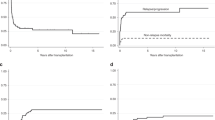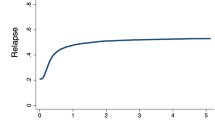Abstract
To evaluate the incidence and risk factors for secondary solid tumors in Japan after allogeneic hematopoietic SCT (allo-HSCT), 2062 patients who had received allo-HSCT between 1984 and 2005 were retrospectively analyzed. Twenty-eight patients who developed 30 solid tumors were identified a median of 5.6 years after transplantation. The risk for developing tumors was 2.16-fold higher than that of the age- and sex-adjusted general population. The cumulative incidence of solid tumors at 10 years after allo-HSCT was 2.4%. The risk was significantly higher for tumors of the skin, oral cavity and esophagus (standard incidental ratio 40.23, 35.25 and 10.73, respectively). No increase in gastric, colon or lung cancer, despite being the most prevalent neoplasm in the Japanese, was observed. In multivariate analysis, occurrence of chronic GVHD and malignant lymphoma as a primary disease was associated with a higher risk for developing solid tumors. Eighteen patients are still alive, and their 5-year probability of survival since diagnosis of solid tumors is 59.7%. Our data suggest that the incidence and risk factors of secondary solid tumors in Japanese allo-HSCT recipients are comparable to those reported in Western countries and emphasize that the early detection of solid tumors has a crucial role in improving OS.
This is a preview of subscription content, access via your institution
Access options
Subscribe to this journal
Receive 12 print issues and online access
$259.00 per year
only $21.58 per issue
Buy this article
- Purchase on Springer Link
- Instant access to full article PDF
Prices may be subject to local taxes which are calculated during checkout


Similar content being viewed by others
References
Gallagher G, Forrest DL . Second solid cancers after allogeneic hematopoietic stem cell transplantation. Cancer 2007; 109: 84–92.
Bhatia S, Louie AD, Bhatia R, O’Donnell MR, Fung H, Kashyap A et al. Solid cancers after bone marrow transplantation. J Clin Oncol 2001; 19: 464–471.
Kolb HJ, Socié G, Duell T, Van Lint MT, Tichelli A, Apperley JF et al. Malignant neoplasms in long-term survivors of bone marrow transplantation: late effects working party of the European cooperative group for blood and marrow transplantation and the European late effect project group. Ann Intern Med 1999; 131: 738–744.
Curtis RE, Rowlings PA, Deeg HJ, Shriner DA, Socíe G, Travis LB et al. Solid cancers after bone marrow transplantation. N Engl J Med 1997; 336: 897–904.
Shimada K, Yokozawa T, Atsuta Y, Kohno A, Maruyama F, Yano K et al. Solid tumors after hematopoietic stem cell transplantation in Japan: incidence, risk factors and prognosis. Bone Marrow Transplant 2005; 36: 115–121.
Matsuda T, Marugame T, Kamo K, Katanoda K, Ajiki W, Sobue T . Cancer incidence and incidence rates in Japan in 2002: based on data from 11 population-based cancer registries. Jpn J Clin Oncol 2008; 38: 641–648.
Vandenbroucke J . A shortcut method for calculating the 95% percent confidence interval of the standardized mortality ratio. Am J Epidemiol 1982; 115: 303–304.
Esteve J, Benhamou E, Raymond L . Statistical methods in cancer research. Volume IV. Descriptive epidemiology. IARC Sci Publ 1994; 128: 1–302.
Gray RJ . A class of K-sample tests for comparing the cumulative incidence of a competing risk. Ann Stat 1988; 16: 1140–1154.
Lin DY . Non-parametric inference for cumulative incidence functions in competing risks studies. Stat Med 1997; 16: 901–910.
Baker KS, DeFor TE, Burns JK, Ramsay NK, Neglia JP, Robison LL . New malignancies after blood or marrow stem-cell transplantation in children and adults: incidence and risk factors. J Clin Oncol 2003; 21: 1352–1358.
Deeg HJ, Socie G . Malignancies after hematopoietic stem cell transplantation: many questions, some answers. Blood 1998; 91: 1833–1844.
Curtis RE, Metayer C, Rizzo JD, Socié G, Sobocinski KA, Flowers ME et al. Impact of chronic GvHD therapy on the development of squamous cell cancers after hematopoietic stem cell transplantation: an international case–control study. Blood 2005; 105: 3802–3811.
Jonas S, Rayes N, Neumann U, Neuhaus R, Bechstein WO, Guckelberger O et al. De novo malignancies after liver transplantation using tacrolimus-based protocols or cyclosporine-based quadruple immunosuppression with an interleukin-2 receptor antibody or antithymocyte globulin. Cancer 1997; 80: 1141–1150.
Winter P, Schoeneich G, Miersch WD, Klehr HU . Tumour induction as a consequence of immunosuppression after renal transplantation. Int Urol Nephrol 1997; 29: 701–709.
Faber P, Fisch P, Waterhouse M, Schmitt-Gräff A, Bertz H, Finke J et al. Frequent genomic alterations in epithelium measured by microsatellite instability following allogeneic hematopoietic cell transplantation in humans. Blood 2006; 107: 3389–3396.
Hasegawa W, Pond GR, Rifkind JT, Messner HA, Lau A, Daly AS et al. Long-term follow-up of secondary malignancies in adults after allogeneic bone marrow transplantation. Bone Marrow Transplant 2005; 35: 51–55.
Leisenring W, Friedman DL, Flowers MED, Schwartz JL, Deeg HJ . Nonmelanoma skin and mucosal cancers after hematopoietic cell transplantation. J Clin Oncol 2006; 24: 1119–1126.
Socie G, Curtis RE, Deeg HJ, Sobocinski KA, Filipovich AH, Travis LB et al. New malignant diseases after allogeneic marrow transplantation for childhood acute leukemia. J Clin Oncol 2000; 18: 348–357.
Witherspoon RP, Fisher LD, Schoch G, Martin P, Sullivan KM, Sanders J et al. Secondary cancers after bone marrow transplantation for leukemia or aplastic anemia. N Engl J Med 1989; 321: 784–789.
Bhatia S, Ramsay NK, Steinbuch M, Dusenbery KE, Shapiro RS, Weisdorf DJ et al. Malignant neoplasms, following bone marrow transplantation. Blood 1996; 87: 3633–3639.
Preston DL, Shimizu Y, Pierce DA, Suyama A, Mabuchi K . Studies of mortality of atomic bomb survivors. Report 13. Solid cancer and noncancer disease mortality. 1950-1997. Radiat Res 2003; 160: 381–407.
Bhatia S, Robison LL, Oberlin O, Greenberg M, Bunin G, Fossati-Bellani F et al. Breast cancer and other second neoplasms after childhood Hodgkin’s disease. N Engl J Med 1996; 334: 745–751.
van Leeuwen FE, Klokman WJ, Veer MB, Hagenbeek A, Krol AD, Vetter UA et al. Long-term risk of second malignancy in survivors of Hodgkin’s disease treated during adolescence or young adulthood. J Clin Oncol 2000; 18: 487–497.
Charles M . UNSCEAR report 2000: sources and effects of ionizing radiation. United Nations Scientific Comittee on the effects of atomic radiation. J Radiol Prot 2001; 21: 83–86.
Neglia JP, Meadows AT, Robison LL, Kim TH, Newton WA, Ruymann FB et al. Second neoplasms after acute lymphoblastic leukemia in childhood. N Engl J Med 1991; 325: 1330–1336.
Cohen A, Rovelli A, van Lint MT, Merlo F, Gaiero A, Mulas R et al. Secondary thyroid carcinoma after allogeneic bone marrow transplantation during childhood. Bone Marrow Transplant 2001; 28: 1125–1128.
Hawkins MM, Wilson LM, Burton HS, Potok MH, Winter DL, Marsden HB et al. Radiotherapy, alkylating agents, and risk of bone cancer after childhood cancer. J Natl Cancer Inst 1996; 88: 270–278.
Tucker MA, D’Angio GJ, Boice Jr JD, Strong LC, Li FP, Stovall M et al. Bone sarcomas linked to radiotherapy and chemotherapy in children. N Engl J Med 1987; 317: 588–593.
Mauch PM, Kalish LA, Marcus KC, Coleman CN, Shulman LN, Krill E et al. Second malignancies after treatment for laparotomy staged IA-IIIB Hodgkin’s disease: long-term analysis of risk factors and outcome. Blood 1996; 87: 3625–3632.
Favre-Schmuziger G, Hofer S, Passweg J, Tichelli A, Hoffmann T, Speck B et al. Treatment of solid tumors following allogeneic bone marrow transplantation. Bone Marrow Transplant 2000; 25: 895–898.
Author information
Authors and Affiliations
Consortia
Corresponding author
Ethics declarations
Competing interests
The authors declare no conflict of interest.
Rights and permissions
About this article
Cite this article
Yokota, A., Ozawa, S., Masanori, T. et al. Secondary solid tumors after allogeneic hematopoietic SCT in Japan. Bone Marrow Transplant 47, 95–100 (2012). https://doi.org/10.1038/bmt.2011.23
Received:
Revised:
Accepted:
Published:
Issue Date:
DOI: https://doi.org/10.1038/bmt.2011.23
Keywords
This article is cited by
-
Decision analysis of allogeneic bone marrow transplantation versus immunosuppressive therapy for young adult patients with aplastic anemia
International Journal of Hematology (2023)
-
Male-specific late effects in adult hematopoietic cell transplantation recipients: a systematic review from the Late Effects and Quality of Life Working Committee of the Center for International Blood and Marrow Transplant Research and Transplant Complications Working Party of the European Society of Blood and Marrow Transplantation
Bone Marrow Transplantation (2022)
-
Three resected cases of esophageal carcinoma considered as being secondary solid tumors after bone marrow transplantation
Surgical Case Reports (2021)
-
The risk of malignancies in patients receiving hematopoietic stem cell transplantation: a systematic review and meta-analysis
Clinical and Translational Oncology (2020)
-
Programmed death 1 ligand (PD-L1) in solid cancers after allogeneic hematopoietic stem cell transplantation: a retrospective analysis by the Nagasaki Transplant Group
International Journal of Hematology (2020)



